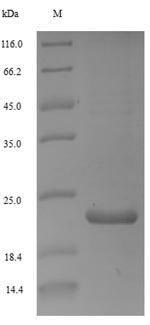The process of expressing the recombinant Woodchuck hepatitis B virus Protein X (X) protein in the E.coli requires the recombinant DNA gene formed by the integration of encoding gene for the 1-141aa of the Woodchuck hepatitis B virus Protein X (X) protein and N-terminal 6xHis tag sequence, the expression vector that the recombinant DNA gene inserts into, the E.coli that provided the necessary macromolecules and components for transcription and translation of the cloned expression vector. After isolation and purification, this N-terminal 6xHis-tagged recombinant Protein X (X) protein was obtained. This recombinant Protein X (X) protein is characterized by high purity (>90%, SDS-PAGE). This Protein X (X) protein ran along the gel to the band of approximately 21 kDa molecular weight.
Protein X (also known as peptide X) is a protein encoding by a gene named X in Woodchuck hepatitis B virus. Protein X has no counterparts in any of its hosts and is conserved among mammalian hepadnavirus. This protein is well known for its transactivation activity through interaction with several cellular transcription factors, In addition to its role in viral replication and chromosomal instability, it is also known as an oncogene involving in modulating oncogenic pathways, oxidative stress, DNA methylation, angiogenesis and migration.






